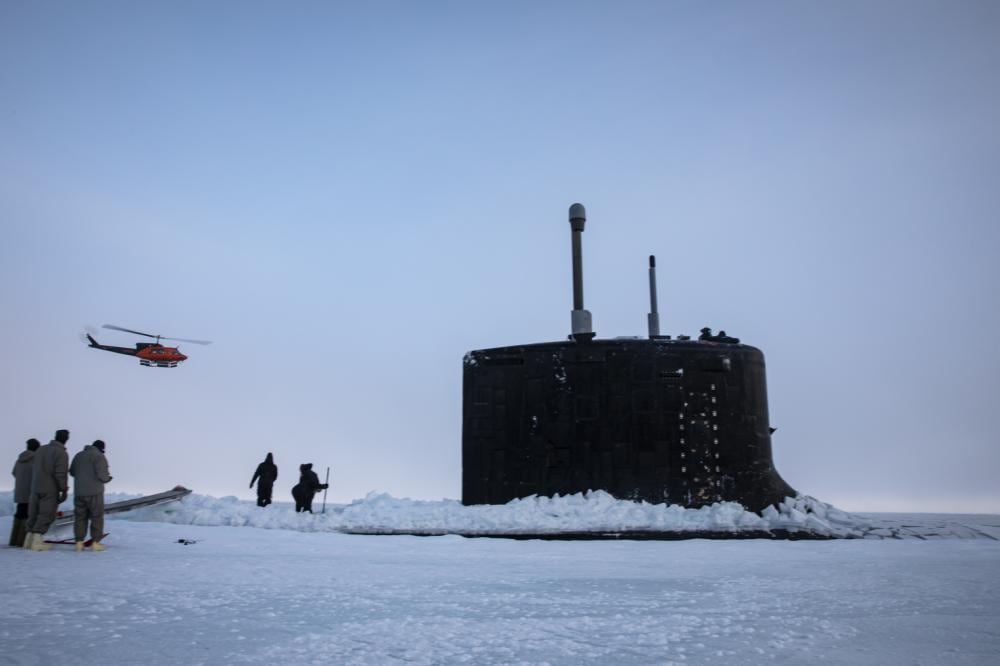Navy divers took to the frigid waters of the Arctic this month during Ice Exercise 2022 to retrieve torpedoes fired by fast attack submarines participating in the biennial exercise.
Divers from both Joint Base Pearl Harbor’s Mobile Diving and Salvage Unit One and Underwater Construction Team One were flown by helicopter to spots in the ice floe where torpedoes fired earlier in the exercise by Virginia-class USS Illinois (SSN 786) and Los Angeles-class Pasadena (SSN 752) submarines were stopped under the ice.
The Navy divers are then tasked with setting up a system similar to an ice-fishing hut and cutting a hole in the ice nearby before plunging into the freezing water, swimming to the torpedo, and directing it through the entry point in the ice.
“You don’t have direct access to air if you need to get air,” Navy diver Lt. Cmdr. Christopher Wilkins, head of dive team MDSU-1, said in a press release. “That’s always in the back of your mind when you’re in an environment like this. You’re working under ice that’s seven feet thick in some places, and the water can be thousands of feet deep. There’s almost no limit to how far down you could fall.”

After navigating the treacherous under-ice waters to bring the ordnance up, divers then hook the torpedoes to cords for a helicopter crew to lift them from the water.
“Under the best of conditions, Navy divers do very dangerous work,” said Rear Adm. Richard Seif, commander of the Navy’s Undersea Warfighting Development Center in Groton, Connecticut, and ranking officer of ICEX 2022. “Diving under the Arctic ice adds another degree of difficulty. ICEX gives our divers an opportunity to work and train in the Arctic, gaining crucial experience that would be impossible to replicate anywhere else on Earth.”
ICEX 2022 — the month-long, joint-exercise with Royal Canadian service members and sailors from the U.K. Royal Navy — took place at Ice Camp Queensfish, a temporary base built on Arctic ice located in international waters 160 nautical miles off the coast of Alaska.
Occurring at the same time as ICEX is U.S. Northern Command’s Arctic Edge, a separate biennial exercise designed to provide realistic training for service members in the region to rapidly deploy to locations throughout the Arctic region. Arctic Edge takes place at Ice Camp Queenfish and Prudhoe Bay, Alaska, over a three-week period, involving about 1,000 participants from the U.S. and Canadian Coast Guards, in addition to employees from the Defense Department and Canada’s Department of National Defense.

Both exercises serve as examples of the U.S. military’s commitment to expanding its presence in the Arctic region as the region warms and ice melts, allowing shipping lanes and territory to emerge that may cause conflict among nations interested in expansion.
“As maritime traffic increases through the Arctic waters, we must work with our partners and allies to project strength and keep this region safe and peaceful,” Assistant Secretary of the Navy for Energy, Installations and Environment, the Hon. Meredith Berger, said after a visit to ICEX Mar. 7. “Ice Exercise 2022 highlights our unique ability to operate in this austere and challenging environment. It’s inspiring to see firsthand what the men and women of our Navy and Marine Corps can do in even the most inhospitable environments on Earth.”
Rachel is a Marine Corps veteran and a master's candidate at New York University's Business & Economic Reporting program.




